Seeking Out Australian Native Orchids #37
Maybe I am starting to turn into a bit of a scientist. My friend posted a photo of a cow orchid (he calls them large tongue orchids) - on his Facebook page.
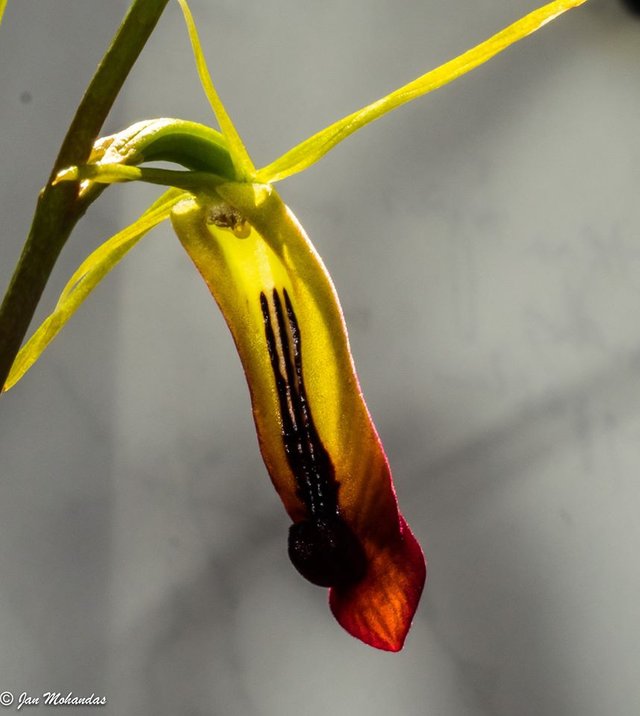
Cow Orchid - Cryptostylis subulata
What struck me about the photo was the very clear deliniation on the underside of the labellum into 3 veins. I do not recall seeing that in my local area. Time to check it out as I know they are flowering at the moment. Here it is
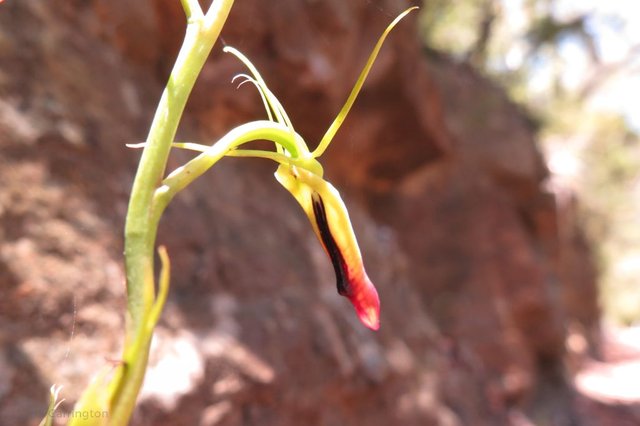
Cow Orchid - Cryptostylis subulata
I took photos of two different flowers on two different plants - both do show a split of that purple line but not to the same extent. The reference guide says
with 2 thick and 2 finer dark longitudinal lines
http://plantnet.rbgsyd.nsw.gov.au/cgi-bin/NSWfl.pl?page=nswfl&lvl=sp&name=Cryptostylis~subulata
There you go. It was a very hot day for a bicycle ride - over 30C when I left home. So, like a crazy man, I decided to add in a walk too to explore the track above Apple Tree Bay.
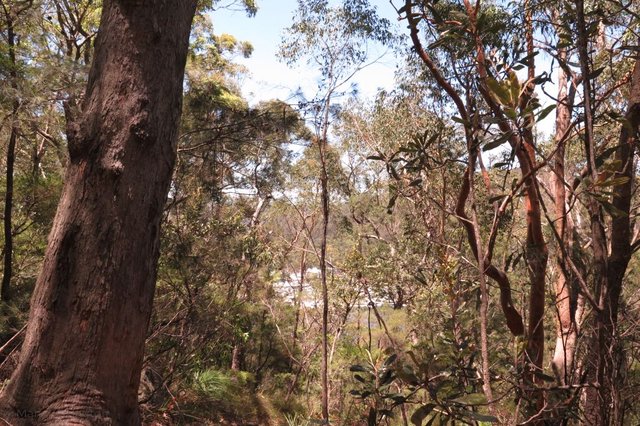
That was a tough gig - and the orchids were somewhat absent. Maybe it would be better to get involved in some sort of boating activity on one of the boats I could see through the trees.
I found a few leaves in one spot only. It has been too dry and too hot. There is a section of rain forest on this track - all dry now.
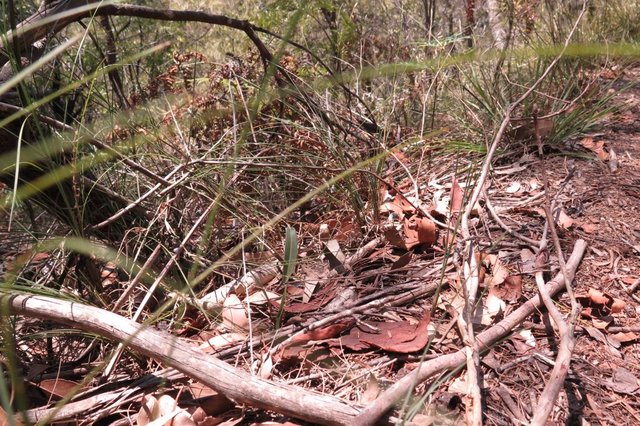
I also found this hole burrowed through the tussocky grass. It is perfectly round in shape - maybe the size of a grapefruit - and there is evidence of footprints at the entrance.
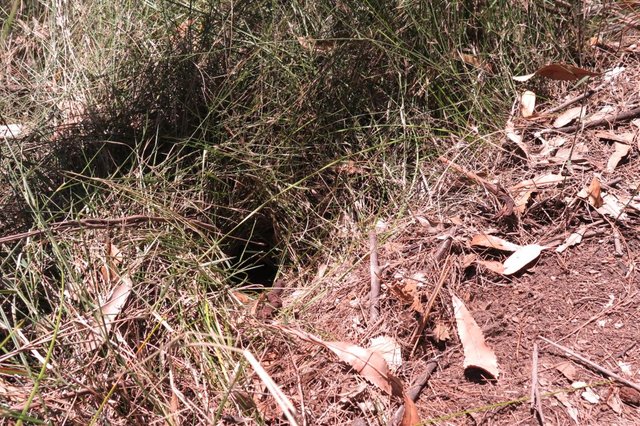
I was not game to stick my hand in to see. I am going to guess echidna as I did see one along this track last time through. I did get to see a lyrebird further down the track but he was way too fast for your photographer. Walking done, I made my way back up the hill. Checked out the plant I have been waiting to catch flowering. No joy there and it looks as if the stem is starting to wither in the heat.
I did find a bunch of mushrooms growing along the road (where the cow orchids are)
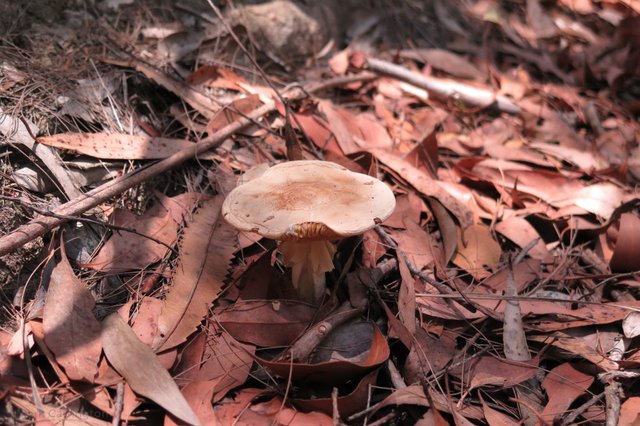
Three more things to do on the way up the hill. Check the status on the 2nd bud of the suspected "horned orchid" is one.
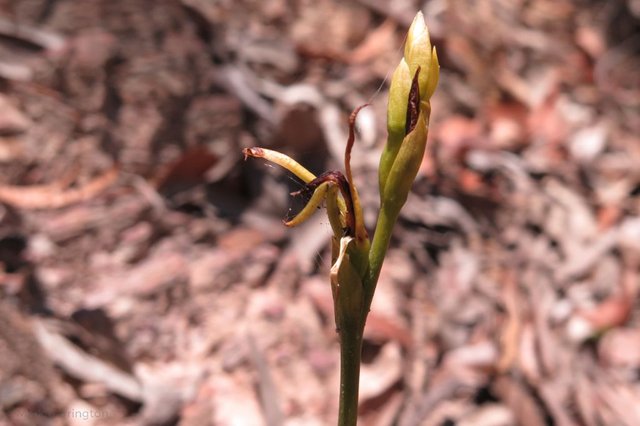
This is not looking good as the 2nd bud is doing exactly what the 1st one did - the top section (i.e., one of the petals) is withering away too just like the other one below. The plant further down the road has not yet sent up a stem. Now I did do a little more research on the variety - the length and shape of the sepals is consistent with a horned orchid but the colouring and the shape of the labellum is not. I have no idea.
I also checked out the secret location photographed last time - the 2nd bud is flowering.
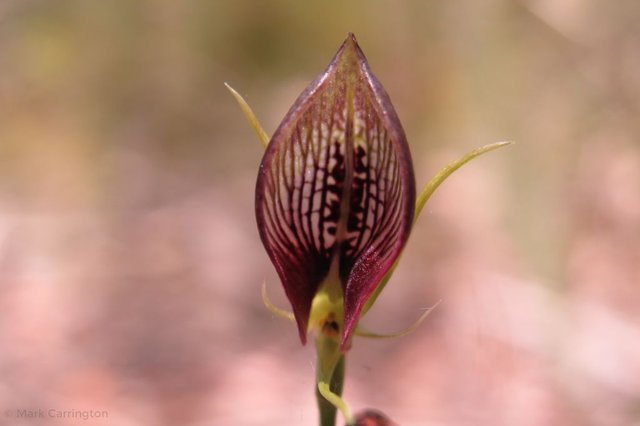
Bonnet Orchid - Cryptostylis erecta
I found this location nearly 20 months ago - just one leaf growing in the basin formed at the foot of the two trees. There is now a trail of plants going down below that basin. In a few more seasons, they will be all along the roadside. I was really struggling to take the photograph with sweat streaming off my body and my head exploding in the heat. No real surprise when I got home to find that the GPS had recorded an "in the sun" temperature of 43C (well over 100F).
On the other side of the road is the other science test. Time to go back to photograph an orchid to check its identification.
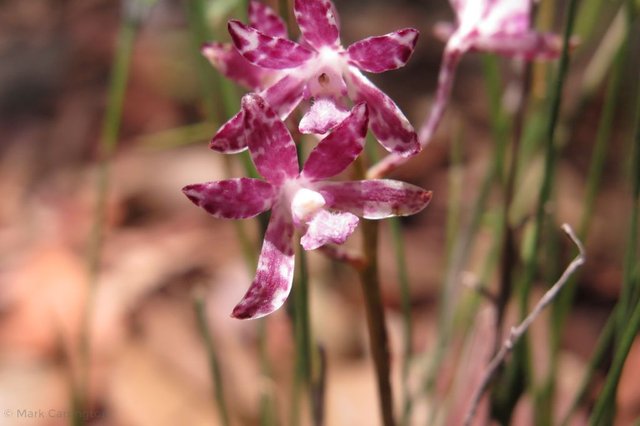
When I look at this on the computer the splotches look pink. To the naked eye they are more purple than pink. My eyes do not deceive me. Time to dig into the reference materials to see what is what.
Dipodium punctatum: Inflorescence 40–100 cm long, 14–60-flowered; pedicel plus ovary 13–30 mm long, pink, unspotted. Sepals and lateral petals slightly cupped to widely opening, straight to slightly recurved, pink with heavy darker purple blotching. Sepals 10–18 mm long, 2.5–4.5 mm wide. Labellum 8–15 mm long, deep pink; callus keels parallel; central band of hairs mauve, narrow basally but widening to cover most of the apical half of the midlobe; midlobe about twice as long as broad.
Dipodium variegatum: Inflorescence 24–80 cm long, 2–50-flowered; pedicel plus ovary 12–25 mm long, cream to light green, spotted with maroon. Sepals and lateral petals slightly recurved, cream to pale pink, heavily marked with maroon blotches. Sepals 7–19 mm long, 2–5 mm wide. Labellum 6–15 mm long, mauve to maroon; callus keels divergent; central band of hairs mauve, narrow basally but widening to cover most of the apical half of the midlobe; midlobe about twice as long as broad.
http://plantnet.rbgsyd.nsw.gov.au/cgi-bin/NSWfl.pl?page=nswfl&search=yes&namesearch=dipodium&dist=
It all comes down to minute differences in the hairs on the labellum and the predominant colourings. Google search does not really help as there are many photographs that are incorrectly identified. I think I will leave science to the scientists.
Note: Photos taken with Canon PowerShot G16 on January 9, 2017
First image Jan Mohandas taken in Blue Mountains on January 7, 2017
Great photos!
I got so much pleasure looking at your photos, you are a great photographer)